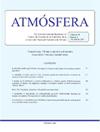利用高空间分辨率WRF模型模拟巴西南部的大雾
IF 1
4区 地球科学
Q4 METEOROLOGY & ATMOSPHERIC SCIENCES
引用次数: 0
摘要
雾是一种将水平能见度降低到1000米或更低的大气现象。这些现象影响着不同的人类活动,主要是与航空、海运和公路运输有关的活动。位于巴西南部的里奥格兰德市是巴西的主要港口之一,该地的大雾天气造成了一些不便,例如港口活动中断和运营成本增加。因此,更好地了解雾的形成和消散,以及随之而来的预报改进,可以为该地区的港口活动带来重大帮助。因此,本工作旨在评估WRF模型模拟格兰德河城市雾事件的能力。为了实现这一目标,进行了四个浓雾研究案例,并进行了灵敏度测试,以选择模型的最佳垂直分辨率配置。对格兰德河引航站和巴西海岸监测系统浮标的气象数据进行了分析。还对研究案例的卫星图像和天气图进行了分析。使用具有三个嵌套域的WRF模型进行数值模拟,其中1km是最高的水平分辨率。对雾稳定性指数(FSI)和两个水平能见度估计值进行了评估。模拟显示了有希望的结果,突出了该模型识别感兴趣区域雾发生情况并表示其消散过程的能力。此外,值得注意的是,FSI和评估的能见度估计对事件的发生很敏感。本文章由计算机程序翻译,如有差异,请以英文原文为准。
Dense fog simulation in southern Brazil using the WRF model with high spatial resolution
Fog is an atmospheric phenomenon that reduces horizontal visibility to 1000 m or less. These phenomena affect different human activities, mainly those associated with air, maritime, and road transport. Rio Grande city, located in southern Brazil, has one of the main Brazilian ports, and fog occurrences at this location cause several inconveniences, such as the interruption of port activities and increases in operating costs. Thus, a better understanding of fog formation and dissipation, and the consequent improvement in its forecasts, can bring significant help to the port activities in that region. Therefore, this work seeks to evaluate the WRF model’s ability to simulate fog events in Rio Grande city. Four study cases of dense fogs were performed for this goal, as well as a sensitivity test to select the best vertical resolution configuration of the model. Meteorological data from the Rio Grande pilotage station and the Brazilian Coastal Monitoring System buoys were analyzed. Satellite images and synoptic charts were also analyzed for the study cases. The numerical simulations were performed using the WRF model with three nested domains, where 1 km was the highest horizontal resolution. The Fog Stability Index (FSI) and two estimates of horizontal visibility were evaluated. Simulations show promising results, highlighting the ability of the model to identify the fog occurrence in the area of interest and represent aspects of its dissipation process. Furthermore, it is noteworthy that the FSI and the evaluated visibility estimates were sensitive to the occurrence of the events.
求助全文
通过发布文献求助,成功后即可免费获取论文全文。
去求助
来源期刊

Atmosfera
地学-气象与大气科学
CiteScore
2.20
自引率
0.00%
发文量
46
审稿时长
6 months
期刊介绍:
ATMÓSFERA seeks contributions on theoretical, basic, empirical and applied research in all the areas of atmospheric sciences, with emphasis on meteorology, climatology, aeronomy, physics, chemistry, and aerobiology. Interdisciplinary contributions are also accepted; especially those related with oceanography, hydrology, climate variability and change, ecology, forestry, glaciology, agriculture, environmental pollution, and other topics related to economy and society as they are affected by atmospheric hazards.
 求助内容:
求助内容: 应助结果提醒方式:
应助结果提醒方式:


